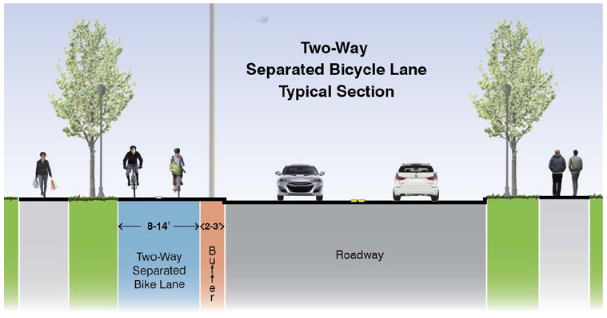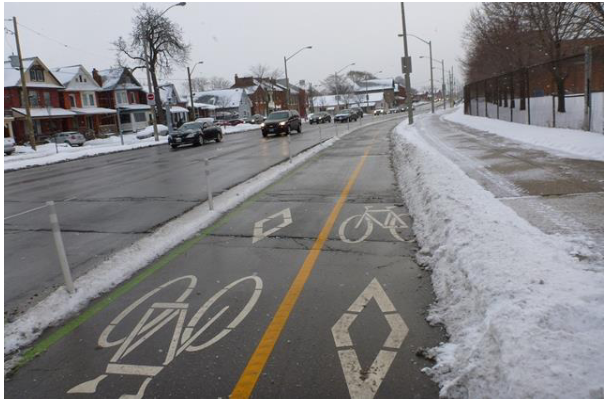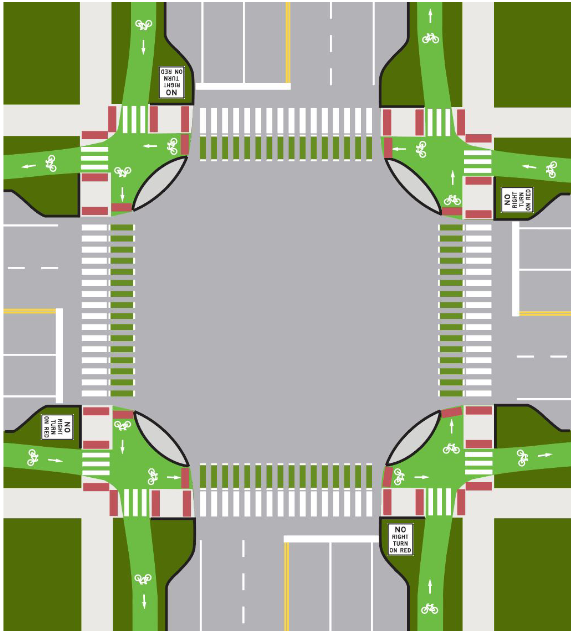Bike West Hartford encourages public feedback on the New Park Avenue Complete Streets Project, based on the Town of West Hartford’s Engineering Division 35% complete plans, and also the alternative proposal raised during the July 7th walk audit. Here’s one response written by Alex Truskowski, a West Hartford resident and occasional bike commuter, which he sent to the New Park Avenue Complete Street Project Engineer, the chair of the West Hartford Pedestrian and Bicycle Commission, and also gave us permission to publish here:
To: New Park Avenue Complete Streets Project (newparkavenue@westhartfordct.gov), Town of West Hartford Assistant Engineer James Brennan (james.brennan@westhartfordct.gov), and West Hartford Pedestrian and Bicycle Commission Chair Ed Pawlak (ecosys88@gmail.com)
From: Alex Truskowski, West Hartford resident and occasional bike commuter
There are several issues that I can see with the current plans for the New Park Ave street reconstruction. All figures that are not from the New Park Ave Complete Streets March 2022 Plans come from the excellent City of Hartford 2019 Bicycle Master Plan.
At the south end of New Park Ave, stopping any bike infrastructure at Sta 9.75 on the plans [Trout Brook bridge] forecloses any possibility of bike infrastructure continuing further south. Without connections further south, the utility of both the trout brook trail (when completed) and the bike lanes on New Park Ave becomes next to zero for people trying to commute on bicycle. For example, without extending to New Britain Ave, there is no possibility of connecting these two routes to Newington or New Britain. There is a great opportunity for a two way separated cycle path (see below) along New Britain Ave that could connect Trout Brook Trail and New Park Ave by bike to Corbin’s Corners/West Farms Mall or to points further south and west.

North of Sta 9.75 [Trout Brook bridge], regardless of if paired one way buffered bike lanes or two way buffered bike lanes are used, the transition to a two way cycle path at the intersection with Talcott Road needs to have a bike specific light phase to allow cyclists to transit the intersection without having to go on the sidewalk and hit a ‘beg button’. This could be implemented by putting inductance coils in the pavement that have been calibrated to a bike wheel and marking the location where bikes should put their wheels to trigger the light phase, such as what is done in Boulder, CO. In addition, there isn’t a clear plan visible to continue the two way cycle path north to connect to the bike lanes on New Park Ave in Hartford or the proposed bike lanes on Oakwood Ave. In addition, there will need to be a plan to deconflict cars turning into West Hartford Place with any potential bike traffic on the two way cycle path.
One way to reduce the need for a bike phase at Talcott Road would be to put a two way buffered bike way on the west side of New Park Ave instead of paired one way bike lanes. However, this would increase the potential for conflicts with cars at both Talcott Road and at every driveway on that side of the road. A good way to call attention to potential cyclists for drivers would be to place bollards that can be removed for plow operations. This would require cars to take tighter turns, slowing them down enough to see potential cyclists.

Another way to call attention to potential cyclists would be to give major intersections Dutch style bump outs as seen below to allow bikes to continue on while slowing cars enough that they can see and react to the cyclist.

Overall the choice of a separated bike path comes with tradeoffs that seem to suggest that the portion of Talcott Road is sacrificing building usable bike infrastructure in order to satisfy level of service goals. This notion is reinforced by the fact that there is nowhere in the original New Park Ave complete streets plan where bike infrastructure is planned north of West Hartford Place when New Park Ave in Hartford already has bike lanes. Level of service is a terrible metric for making a road more usable for all users including cars. See the North Main Street road diet for an example of that. That road reduced through lanes and made the experience of driving that section less frustrating while giving cyclists a place to ride without having many conflicts with cars. A large part of what makes the North Main St road diet less frustrating as a driver is that it allows people who are making a left to stop somewhere where they aren’t blocking a through lane. This makes it better for everyone. There are many roads in West Hartford where there are two travel lanes in each direction with no turn lanes where the vast majority of the time people turning make it effectively one travel lane in each direction. This is the case on New Britain Ave and on South Main Street. South Main Street is especially insulting to bicyclists since it puts sharrows on an arterial road where they are worse than useless. Prioritizing level of service over having coherent bike/pedestrian infrastructure will just make the road worse for everyone.
It is my opinion that the typical section in the plans for Sta 9+73 to Sta 27+92 [from Trout Brook Trail entrance to Talcott Road] should be the typical section for the entire length of New Park Avenue in West Hartford in order to connect the bike lanes on the Hartford portion of New Park Ave all the way to the Trout Brook Trail and provisions be put in place such as only making one turn lane in each direction and/or making a bus only turn lane to extend the bike lanes to New Britain Ave simply by restriping in the event that bike infrastructure is created along the New Britain Ave corridor.


Overall, the current plan seems like it will simply be a waste of money unless provisions are created for future connections to other current and future bike infrastructure.
Any road that goes to the Hartford-West Hartford border where the City of Hartford plans to build bicycle infrastructure in their master plan should be made a priority for West Hartford to build matching bike infrastructure to allow for uninterrupted and simple bike journeys.
